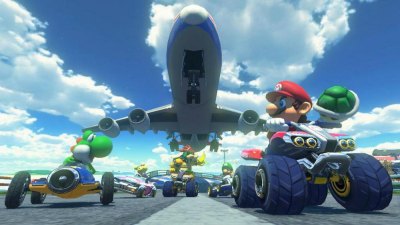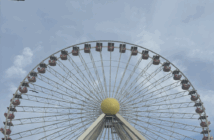According to Nintendo Japan’s website, the newest entry in the long-running “Mario Kart” series has been given a worldwide release date of May 30.
“I’m extremely excited for the new “Mario Kart.” It’s the main title outside of the new Super Smash Bros. that makes me want a Wii U. I’m most excited to experience one of my favorite titles in HD,” said Freshman Preston Stutzman.
At its core, “‘Mario Kart’ is a racing game; the goal of the game is to reach the finish line first. However, the series takes the concept a step further by allowing racers to fight and sabotage each other with weapons – also known as items – placed around the track. Each item takes only the press of a button to use, and each item gives players a better chance to win a race. These mechanics give “Mario Kart” an accessible yet deep feel, turning the series into one of the most well-known party games.
The “Mario Kart” series is an important piece of Nintendo’s history. Mario and his friends have hosted races in the fictional Mushroom Kingdom for over twenty years, pioneering the kart racing genre in the early 1990s. A new game is added to the series with each new Nintendo system; it’s been this way ever since the series’ first game.
“‘Mario Kart’ is practically a traditional game in the sense that I’ve expected a new one every few years ever since I was a kid,” said Maxx Howarth, Freshman. “It reminds me a lot of the ‘Harry Potter’ movies.”
With each new entry into the franchise, new features are added to enhance and freshen the gameplay of the series. For instance, “Mario Kart: Double Dash!!” introduced co-operative play, allowing two players to control a single kart and race together.
As another example, “Mario Kart 7” added gliders and propellers to the series. This allowed for racers to drive not only on land, but also underwater and in the air.
Perhaps the most iconic feature of the series, however, is something that has been in every game within it—Rainbow Road: the final racetrack of each game and, arguably, the most difficult. With each game, a new Rainbow Road is designed specifically to embrace whatever new gameplay features are brought to the table. “Mario Kart 8” is adding anti-gravity racing to the series—meaning that racers will now be able to race upside down or even on walls. These new features will affect the inevitable inclusion of Rainbow Road as well.
Rainbow Road is also known for its scenery and background music. Starry space, flashy surfaces, and insane risks all define Rainbow Road.
“Rainbow Road is possibly the most aggravating but most intellectually thought-out course throughout all of ‘Mario Kart,’” said Cody Agen, Freshman. “It doesn’t always have the most graphic displays, but it makes up for this with its difficulty and its variety of colors.”
Rainbow Road has evolved just as much as the games themselves have, becoming more complicated with each entry. Because of this, understanding Rainbow Road itself is a great way to understand the “Mario Kart” series’ history.
The series itself began in 1992 with “Super Mario Kart” for the Super Nintendo. The simplest of the series in terms of gameplay, this game’s Rainbow Road and was full of sharp ninety-degree turns. As a track hazard, Thwomps—giant, living bricks that crashed down on racers—were also included. This track was extremely narrow for having eight racers on it at a time; one wrong move could easily cause racers to fall off of the track.
“Mario Kart 64” was the second game in the series, released for the Nintendo 64 in 1996. With enhanced graphics, “Mario Kart 64” made Rainbow Road even more of a treat to look at with flashy images of characters gracing the stars. The entire track is lined with guardrails and is full of straightaways. This prevents even the clumsiest of racers from falling off the track. For this version, the challenge itself comes from the absurd length of the track—a single lap can take almost two full minutes to complete. Catching up to lead racers, even with the strongest of items, is no easy task in this edition of the track.
The Rainbow Road featured in “Mario Kart: Super Circuit” was full of twists, turns, and large, risky jumps, making it one of the most dangerous. Guardrails were also quite scarce here, and ninety-degree turns were plentiful. “Super Circuit”was released for the Game Boy Advance in 2001.
“Mario Kart: Double Dash!!” (2003), “Mario Kart DS” (2005), and “Mario Kart Wii” (2008) all featured Rainbow Roads each with a similar feel, but each with very different designs. “Mario Kart: Double Dash!!” featured a Rainbow Road suspended above a city. It included several twists and dangerous U-turns along with a rainbow-colored pipe that launched racers high into the air. “DS’s” Rainbow Road included a corkscrew and a loop for some spiraling action. The Rainbow Road in “Mario Kart Wii” featured almost no guardrails at all and was full of half-pipes, jumps, and pitfalls. These games were released for the Nintendo GameCube, DS, and Wii respectively.
The most recent Rainbow Road appeared in “Mario Kart 7” for the Nintendo 3DS, released in 2011. This track featured two gliding sections, very little guardrails, and even included a trip to a moon with altered gravity.
“My favorite Rainbow Road would most likely have to be the one from ‘Mario Kart: Double Dash!!,’” said Ravin Forde, Senior. “For one, it was the only one I’ve ever encountered and the only one I was ever able to beat,” he said.
With “Mario Kart 8” waiting just around the corner, Wii U owners everywhere will probably be screaming at the top of their lungs again as they try to keep themselves on the track – all with an anti-gravity twist.
When asked how well he thought he’d perform in “Mario Kart 8’s” Rainbow Road for the first time, Matthew Martin, Sophomore, didn’t seem very confident as he considered the track’s possible difficulty.
“I would definitely play like garbage. I wouldn’t get first place – Rainbow Road’s always been hard for me,” he said. “I don’t agree with how there’s no barriers on the outside of the track, and that always causes a lot of problems. Maybe fourth or fifth—probably not last—but it wouldn’t be what I would like it to be.”






